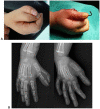Thumb Duplication Surgical Treatment: Outcomes and Results
- PMID: 36704245
- PMCID: PMC9871972
- DOI: 10.1177/2333794X221149828
Thumb Duplication Surgical Treatment: Outcomes and Results
Abstract
Aim: This study aims to evaluate functional and esthetic outcomes of thumb duplication correction in pediatric age.
Methods: Retrospective study including all pediatric patients with thumb duplication undergoing surgical treatment between 2012 and 2017. We analyzed demographic data, surgical technique, and surgical outcomes considering Tada, Horii, and Tien scores, according to the following parameters: active mobility of the metacarpophalangeal and interphalangeal joints, stability, alignment, and family's opinion about cosmetic and function of the thumb. The Wassel-Flatt classification was used to classify the duplicated thumbs.
Results: A total of 11 patients were included, predominantly male (ratio 1.8:1), with a median age at time of surgery of 19[10-26] months and a median follow-up time after surgery of 23 [3-63] months. The Wassel- Flatt type IV thumb was the most frequent (73%). The postoperative evaluation revealed that 82% of patients had good results in Tada score, 73% had good results in Horii score, and all patients showed good results in Tien score. We found a relation between lower age and fair postoperative alignment (P = .047) and between fair postoperative alignment and fair final Tada (P = .022), Horii (P = .006), and Tien (P = .009) scores.
Conclusions: Excision and reconstruction procedures are good options in the treatment of thumb duplication providing good clinical results, with excellent parent satisfaction. Timing of surgery is important for favorable esthetic outcomes, while angular deformity is a determining factor that for postoperative dissatisfaction.
Keywords: functional and aesthetic outcomes; paediatric; surgery; thumb duplication.
© The Author(s) 2023.
Conflict of interest statement
The author(s) declared no potential conflicts of interest with respect to the research, authorship, and/or publication of this article.
Figures



Similar articles
-
Surgical reconstruction in Wassel type IV thumb duplication.Acta Orthop Traumatol Turc. 2014;48(2):181-6. doi: 10.3944/AOTT.2014.13.0042. Acta Orthop Traumatol Turc. 2014. PMID: 24747627
-
[Optimal surgical timing and treatment of thumb duplication in children].Zhonghua Zheng Xing Wai Ke Za Zhi. 2013 Sep;29(5):336-40. Zhonghua Zheng Xing Wai Ke Za Zhi. 2013. PMID: 24409773 Chinese.
-
Flexor pollicis longus rebalancing: a modified technique for Wassel IV-D thumb duplication.J Hand Surg Am. 2014 Jan;39(1):75-82.e1. doi: 10.1016/j.jhsa.2013.10.003. J Hand Surg Am. 2014. PMID: 24369941
-
Thumb duplication: concepts and techniques.Clin Orthop Surg. 2012 Mar;4(1):1-17. doi: 10.4055/cios.2012.4.1.1. Epub 2012 Feb 20. Clin Orthop Surg. 2012. PMID: 22379552 Free PMC article. Review.
-
Radial Polydactyly. What's New?Curr Pediatr Rev. 2018;14(2):91-96. doi: 10.2174/1573396314666180124102012. Curr Pediatr Rev. 2018. PMID: 29366421 Review.
Cited by
-
Clinical Effects of Distal Phalanges and Nail Bed Fusion in Type III Thumb Duplication.Plast Reconstr Surg Glob Open. 2025 Mar 12;13(3):e6545. doi: 10.1097/GOX.0000000000006545. eCollection 2025 Mar. Plast Reconstr Surg Glob Open. 2025. PMID: 40078620 Free PMC article.
References
-
- Wassel HD. The results of surgery for polydactyly of the thumb. A review. Clin Orthop. 1969;64:175-193. - PubMed
LinkOut - more resources
Full Text Sources

